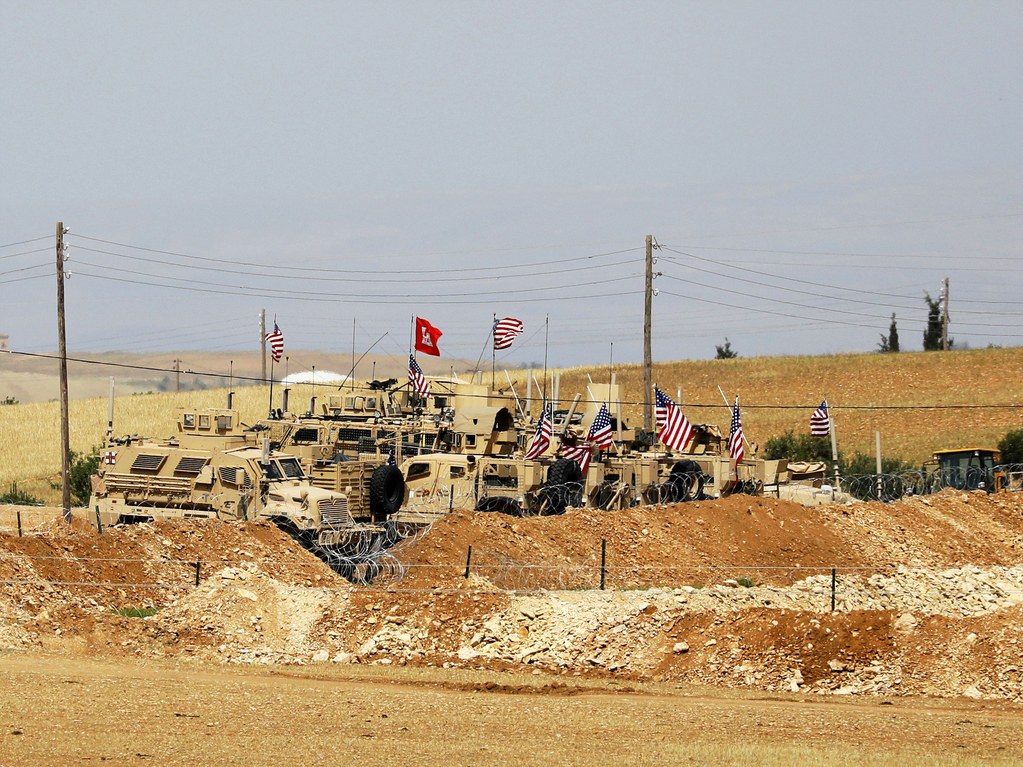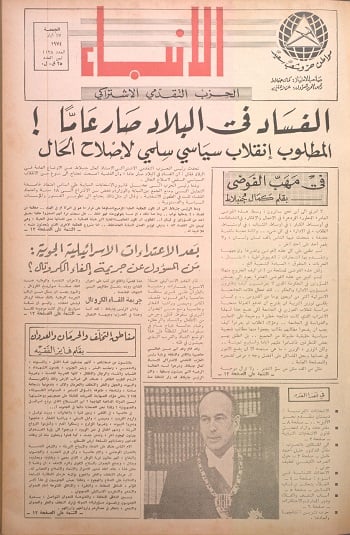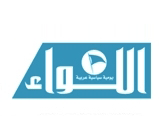Is the Trump Administration Pivoting the Fight in Syria Toward a War with Iran?
By Seth Harp / New Yorker
27 نوفمبر 2018

The largest American military base in Syria covers more than five hundred acres, but it can’t be seen from the road. When I visited in mid-October, on the condition that I not reveal the exact location, I thought my taxi-driver had brought me to the wrong place. All I saw were a few Kurdish soldiers standing around a barricade. But, past the checkpoint and up a hill, a vast encampment spread out before us. The perimeter was constructed of dirt berms, sod-filled gabions, and razor wire. The runway was more than a mile long, and sunk below grade, so that planes would seem to disappear as they landed. There were hastily constructed wood buildings, huge clamshell tents, stacks of shipping containers, rows of white trucks and sport-utility vehicles, prefabricated trailers housing showers and latrines, and a dusty athletic field where soldiers were jogging around a track in the desert twilight.
Inside the main gate were soldiers, sailors, airmen, and marines, and many others in civilian attire wearing sidearms or carrying assault rifles. Quite a few were women. Everyone looked well fed. There was a telecommunications tower, and the Wi-Fi was the best I’d had in weeks of reporting around Syria. A small store sold cigarettes, snacks, candy, energy drinks, and protein powder, as well as cheap souvenirs like kaffiyehs and fake daggers. For fifteen dollars, I bought a sweatshirt that said “Syriagonia” instead of Patagonia.
The American intervention in Syria, now in its fourth year, began as a small Special Forces mission of the kind the Pentagon is currently running in a dozen countries. In the fall of 2015, when President Barack Obama deployed fifty commandos to advise the Syrian Kurds in their war with the Islamic State, his Administration denied that he was breaking his promise not to put “boots on the ground.” “We have run special ops already,” Obama said, “and, really, this is just an extension.” Since then, the number of military personnel in the country has steadily grown, first to two hundred and fifty, then to five hundred, then to two thousand, and there’s reason to believe the true figure is now twice that. (During a press briefing in October, 2017, an Army general let slip that the number was four thousand.) Congress has not authorized military action in Syria, nor is there a United Nations mandate permitting the use of force. Nevertheless, over the last three years, the mission has morphed into something more like a conventional ground war. The United States has built a dozen or more bases from Manbij to Al-Hasakah, including four airfields, and American-backed forces now control all of Syria east of the Euphrates, an area about the size of Croatia. Four U.S. service members have died in Syria. But, because Operation Inherent Resolve, as the Pentagon calls its mission here, falls under the authority of the Joint Special Operations Command, known as jsoc, basic facts are kept classified, including the cost of the mission, the units involved, where they are located, and the number of wounded, which is believed to be substantial.
The stated purpose of the operation, which also comprises western Iraq, is to defeat the Islamic State. Under Obama, an American-backed, Kurdish-led coalition of militias known as the Syrian Democratic Forces, or S.D.F., seized isis territory through 2016, in large part thanks to American airpower, which decimated isis positions in advance of the Kurdish infantry. The S.D.F. had the Islamic State’s capital city, Raqqa, surrounded by that winter, but the offensive stalled when Donald Trump took office. Trump, whose family has financial ties to Turkey, was then currying favor with President Recep Tayyip Erdoğan, who is violently hostile to ethnic minorities, especially the Kurds. For three months, Trump’s generals tried and failed to come up with an alternative plan. In the end, Trump quietly doubled down on Obama’s strategy and upped the number of commandos, sent conventional troops, including marines, and reinforced the S.D.F. with weapons and vehicles. Raqqa fell to the S.D.F. in October of 2017, and the Islamic State ceased to exist as a territorial polity.
Today, the American commandos and marines are down the Euphrates River Valley in Deir Ezzor, supporting the S.D.F. in a final offensive against the last pocket of isis territory in Syria. Meanwhile, the Assad regime, freed from having to fight the Islamic State on its own, is on the verge of defeating the remaining Sunni rebels in Idlib. Turkey is still a wild card, but the once-cluttered battlefield map is increasingly divided between just two coalitions: the Russia-Iran-Assad alliance, in control of two-thirds of the country, including Damascus, Aleppo, and Homs, and the American-backed S.D.F., in control of the rest, including Raqqa. That raises the possibility of a negotiated peace, given that the Kurds and President Bashar al-Assad have never declared war on each other, and the United States and Russia have no interest in clashing militarily. The American government’s two declared goals in Syria are to defeat the Islamic State militarily and to usher Assad out through some kind of political transition. The first is nearly accomplished, but the second is off the table, according to the Russians, who are in a position to dictate what happens in Damascus. It might make sense for Trump to simply declare victory against the Islamic State and walk away, except for one thing: Iran.
Apart from Russia, Iran has been the Assad regime’s biggest backer since the war began. The Revolutionary Guard and the Quds Force are spearheading a large contingent of Afghan and Pakistani mercenaries in Syria, and Iran-aligned Hezbollah has also thrown in with Assad’s Army. For the most part, the Shiite coalition’s war on the Sunni rebels has taken place west of the Euphrates, separate from the Kurds’ war with the Islamic State. But there have been isolated incidents of American forces shooting down Iranian drones, or bombing Shiite militiamen, especially around the al-Tanf border crossing with Iraq, where jsoc has an outpost to block Iranian access to the Baghdad-Damascus highway.
This past March, Trump announced that American personnel would be withdrawing from Syria “very soon.” In April, following the resignation and felony guilty plea of his first national-security adviser, Michael Flynn, and the firing of his replacement, H. R. McMaster, the office fell to John R. Bolton, an unrepentant architect of the Iraq War. Earlier in the year, Bolton had said on Fox News, “Our goal should be regime change in Iran.” A month after Bolton joined the White House, the Trump Administration reneged on the Iran nuclear deal and reimposed sanctions meant to strangle the Iranian economy. Brian Hook, a Bolton aide during the Bush Administration, is now Trump’s “special representative for Iran.” James F. Jeffrey, a diplomat who served as Bush’s chargé d’affaires in Baghdad, is now the “special representative for Syria engagement.” On September 6th, Jeffrey announced that Trump had agreed to keep U.S. troops in Syria indefinitely.“We are not in a hurry,” he said. On September 22nd, Trump’s personal lawyer Rudy Giuliani spoke at an Iran Uprising summit held in Manhattan. “I don’t know when we’re going to overthrow them,” he said. “It could be in a few days, months, a couple of years. But it’s going to happen.” On September 24th, Bolton confirmed to reporters in New York that American troops would not withdraw from Syria until all Iranian forces were gone, including Iranian “proxies and militias,” which could describe any number of armed groups, including the Assad regime itself. He went on to call Iran a “rogue regime,” and released a National Security Council document designating Iran the United States’ top counterterrorism priority. On September 28th, Secretary of State Mike Pompeo ordered the evacuation of the American consulate in Basra, in the far south of Iraq, based on the questionable claim that it had come under rocket fire from Iranian militias. This redux of the Iraq War road show culminated on September 25th, when, in a speech to the United Nations General Assembly—at the same lectern where Bush threatened Saddam Hussein, in 2002—Trump said, of Iran, “We cannot allow the world’s leading sponsor of terrorism to possess the planet’s most dangerous weapons.”
 عن أمل جنبلاط المتجدد: لبنان يستحق النضال
عن أمل جنبلاط المتجدد: لبنان يستحق النضال
 صحافيون أم عرّافون!
صحافيون أم عرّافون!
 ماذا يجري داخل أروقة بيت الكتائب المركزي؟
ماذا يجري داخل أروقة بيت الكتائب المركزي؟


 عن الخرائط التي تُرسم والإتفاقات التي تتساقط!
عن الخرائط التي تُرسم والإتفاقات التي تتساقط!
 “الإنحراف في الحياة”/ بقلم كمال جنبلاط
“الإنحراف في الحياة”/ بقلم كمال جنبلاط
 هاشتاغ #صار_الوقت يحل أولاً في حلقة جنبلاط
هاشتاغ #صار_الوقت يحل أولاً في حلقة جنبلاط
 طاولة نقاش عن أزمة الصحافة في جامعة AUST
طاولة نقاش عن أزمة الصحافة في جامعة AUST
 عبدالله: ليظهر لنا وزير مكافحة الفساد حرصه في صفقات البواخر والفيول
عبدالله: ليظهر لنا وزير مكافحة الفساد حرصه في صفقات البواخر والفيول
 عبدالله: غريب أمر وزارة مكافحة الفساد!
عبدالله: غريب أمر وزارة مكافحة الفساد!

 Comment to Uri Avnery: How Sad What Is Looming Ahead
Comment to Uri Avnery: How Sad What Is Looming Ahead
 “Not Enough!”
“Not Enough!”
 … لمن لم يقرأ يوسف البعيني/ بقلم وسام شيّا
… لمن لم يقرأ يوسف البعيني/ بقلم وسام شيّا
 كمال جنبلاط في مولده الأول بعد المائة: تعاليمه وأفكاره ما زالت الحلّ/بقلم عزيز المتني
كمال جنبلاط في مولده الأول بعد المائة: تعاليمه وأفكاره ما زالت الحلّ/بقلم عزيز المتني
 رئيس حزب/ وليس (… سابقاً)/ بقلم د. خليل احمد خليل
رئيس حزب/ وليس (… سابقاً)/ بقلم د. خليل احمد خليل
 التوازن السياسي في لبنان
التوازن السياسي في لبنان
 لبنان… مشاريع انقلابية مؤجلة
لبنان… مشاريع انقلابية مؤجلة
 جنبلاط وحَمَلة أختام الكاوتشوك
جنبلاط وحَمَلة أختام الكاوتشوك
 Le Liban est un symbole de tolérance
Le Liban est un symbole de tolérance
 Our Automated Future
Our Automated Future
 The True Origins of ISIS
The True Origins of ISIS
 Les Misérables vs. Macron
Les Misérables vs. Macron
 عذراً أيها المعلم/ بقلم مهج شعبان
عذراً أيها المعلم/ بقلم مهج شعبان
 رساله الى المعلم / بقلم ابو عاصم
رساله الى المعلم / بقلم ابو عاصم
 إلى روح القائد والمعلم كمال جنبلاط/ بقلم أنور الدبيسي
إلى روح القائد والمعلم كمال جنبلاط/ بقلم أنور الدبيسي
 أسرار وعناوين الصحف ليوم الجمعة 14 كانون الاول 2018
أسرار وعناوين الصحف ليوم الجمعة 14 كانون الاول 2018














